Account of a life story fact-finding
Igor Komarovsky
It was as far back as 2003 when the World-Wide Club of Odessites has received a letter which was later published in the World-Wide Odessa News newspaper in a habitual feedback hope.
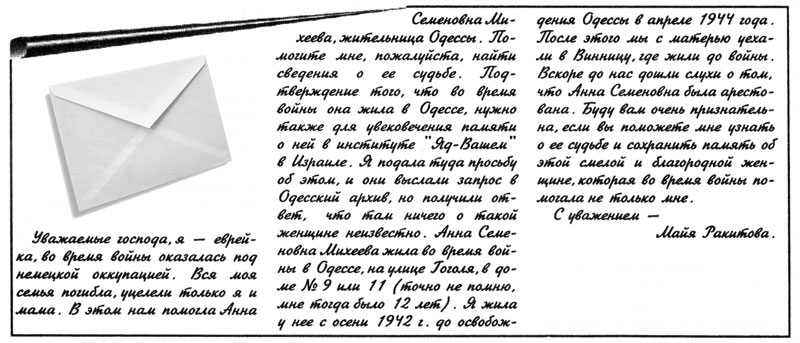
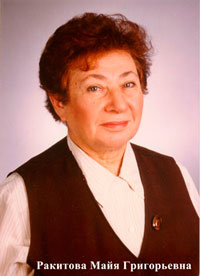 There was a precedent with Voinovich, a former Soviet writer residing in Germany who wanted to find his Odessa kin branch: sooner than a month after the publication the nearest and dearest have met .
There was a precedent with Voinovich, a former Soviet writer residing in Germany who wanted to find his Odessa kin branch: sooner than a month after the publication the nearest and dearest have met .
But this time complete silence was the sole answer.
It was not until 2009 when an archival researcher Igor Komarovsky visited our Club. He was, and still is, an aide to Vladimir Smirnov, the author of “Requiem of the XX Century” unique multi-volume edition – an epic on victims of political repressions in the former USSR that includes abundant materials from the SBU* archives – diaries, letters, legal papers along with the several decades long everyday diaries of V.A. Shvets, a 1940-1945 Odessa Conservatoire student, and after that – a teacher of the famous P.S. Stolyarsky musical school.
Igor Komarovsky started actively assisting the Club in compiling materials for a “They Are Imprinted into Odessa History” biographical e-directory.
Provided with all World-Wide Odessa News quarterly numbers for its 13 years, amidst the letters both to the Club and to the editor he singled out the one above, from Canadian citizen Maya Rakitova, and decided to trace back the life story of Anastasia Mikheyeva, the subject of the appeal.
The results of the scrupulous work seem to be very interesting and worth being presented for all to become familiar with another Righteous of the World from our city.
Leonid Roukman
Director
The World-Wide Club of Odessites
The letter from Maya Rakitova published by the World-Wide Odessa News quarterly newspaper is of rare kind: to-day, 70 years after the WWII, those who survived and now get themselves engaged in quest of their saviors are scarce. My instantaneous wish was to attempt helping the author. In answer to my e-mail I received a telephone call from Canada.
Primarily, I was curious to know how many people answered her appeal, and was astonished to hear that not a single Odessa journalist, historian, or regional studies expert got interested in that dramatic human lot.
History is percepted by many on a States interrelation scale of which opinion I am a strict opponent. As to me, in order to get a real insight into what has in fact occurred during the previous epochs, however difficult it is, one has to try restoring the life stories of separate people whom I regard as the true ones to direct the history.
I hope the reader will forgive me but I have to say something about the Maya Rakitova family of the pre-war period.
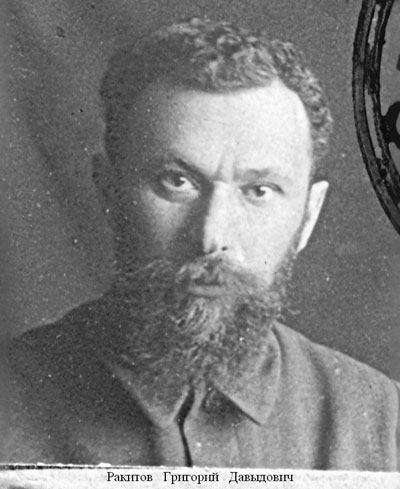 Grigory Rakitov
Grigory Rakitov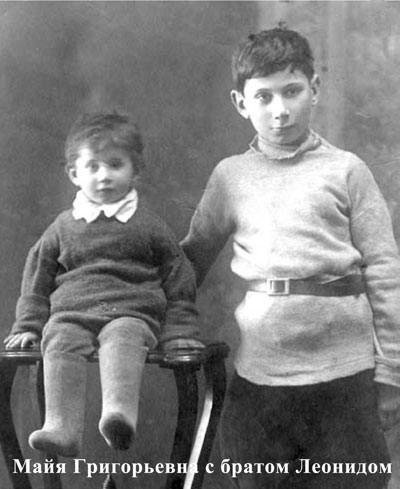 Maya Rakitova with her brother Leonid
Maya Rakitova with her brother Leonid
Her father – Grigory Rakitov – was among those who strived for establishing Soviet power in Vinnitsa (Ukraine) after the 1917 October Revolution in Russian Empire; in 1918 he became an Odessa University student and, simultaneously, the leader of the Spartak - students’ undercover organization – during the WWI Austro-German occupation of Odessa (1918). He got acquainted to Kotovsky (a widely known Red Army commanding officer), after that – 1919 through 1921 - was enlisted as a commissar to the Iona Yakir (a prominent Red Army commander) division. Afterwards he used to hold top-level executive offices both in Ukraine and Russia. Since May 1937 – the head of Kursk (Russia) Regional Executive Committee; arrested in the first days of June, 1937 and executed by shooting in Moscow in October. (Rehabilitated in 1956).
Pursuit of the Grigory Rakitov photo was not a trivial one. But still I was lucky to dig out a miraculously kept safe in the Communist Party archives (in Moscow) photo of Maya Rakitova’s father whom she does not remember almost at all.
Jeopardized by a possible arrest as a “people’s enemy” spouse, Maya Rakitova’s mother was on permanent go from town to town together with her two children. She was caught by war in Vinnitsa (Ukraine). It was a miracle that she and Maya have escaped the shooting extermination of Jews by Nazis in September 1941.
Time went by, and soon they found themselves within the Romanian zone of occupation (Transnistria*) where Maya’s mother managed to get a new passport (she was advised to submit an application to police stating that her previous passport had been withdrawn by the Soviet authorities to be substituted by a new one, and the war hindered her from receiving it. Five persons witnessed the fact).
 19 Gogol St., OdessaIn order to make Maya safe the girl was baptized. Thus both of them have become Russian orthodox. In 1942 staying in Vapnyarka (Vinnitsa region, Ukraine) Maya’s mother quite by sheer luck has met Anastasia Mikheyeva who was there on a friendly visit. And it was owing to her that Maya Rakitova was rescued, because despite her “regular” papers the girl’s Jewish appearance spoke for itself. All 4 years of Romanian occupation Maya (Marusya) has spent at Anastasia Mikheyeva’s place: 19, Gogol St., Odessa.
19 Gogol St., OdessaIn order to make Maya safe the girl was baptized. Thus both of them have become Russian orthodox. In 1942 staying in Vapnyarka (Vinnitsa region, Ukraine) Maya’s mother quite by sheer luck has met Anastasia Mikheyeva who was there on a friendly visit. And it was owing to her that Maya Rakitova was rescued, because despite her “regular” papers the girl’s Jewish appearance spoke for itself. All 4 years of Romanian occupation Maya (Marusya) has spent at Anastasia Mikheyeva’s place: 19, Gogol St., Odessa.
During our telephone talk Maya Rakitova made it clear that it was quite a long time she had been petitioning for awarding Anastasia Mikheyeva The Righteous of the World title (but alas! unsuccessfully: she had no documents to verify the facts which will be further highlighted). Besides, she provided me with a copy of an International Red Cross answer stating futility of her attempts to find information on Anastasia Mikheyeva.
 I was puzzled: wherefrom to start? As it was all about a person – savior of Jewish children during Romanian occupation of Odessa who was arrested and convicted later on by Soviet authorities, I realized that I had to turn primarily to information on victims of political repressions in the Soviet Union (under Stalin). The proper lists cited a certain Mikhleva. I guessed it was a misprint and was pleased to find (frankly, not at once) a mentioned printing error: one should read Mikheyeva instead of Mikhleva!
I was puzzled: wherefrom to start? As it was all about a person – savior of Jewish children during Romanian occupation of Odessa who was arrested and convicted later on by Soviet authorities, I realized that I had to turn primarily to information on victims of political repressions in the Soviet Union (under Stalin). The proper lists cited a certain Mikhleva. I guessed it was a misprint and was pleased to find (frankly, not at once) a mentioned printing error: one should read Mikheyeva instead of Mikhleva!
The Mikheyeva conviction record of proceedings is preserved in the archives of the Security Service of Ukraine Head-Office in Odessa Region. Basically, it is not an easy task to get access to papers in that sort of a government agency. The dossier was attentively scrutinized at my request both by Vladimir Smirnov, the “Odessa Memorial” deputy head of the board and his wife Nina Smirnova whose help I highly appreciate.
I shall try to briefly summarize the process of investigation. March 30, 1945 was the day when approval of an arrest was issued, which was followed by a March 31, 1945 arrest and search warrant. On August 11, 1945 the Odessa Railroad court martial has imposed a sentence: ”to deprive of liberty for 6 years with serving the term of imprisonment in a CLC (correctional labor colony), with the following 3 year disfranchisement, with forfeiture of estate”.
What on earth was going on at the trial? Our times are different, thus I suggest that a reader should try to understand, if only a little, the realities of the severe epoch gone.
The starting point was a delation against Mikheyeva, an overspread practice in Stalin’s time.
We can form an opinion of the trial only from Mikheyeva’s statements; but to be honest one must remember that confession of one’s guilt was very often attained by illegal means those years.
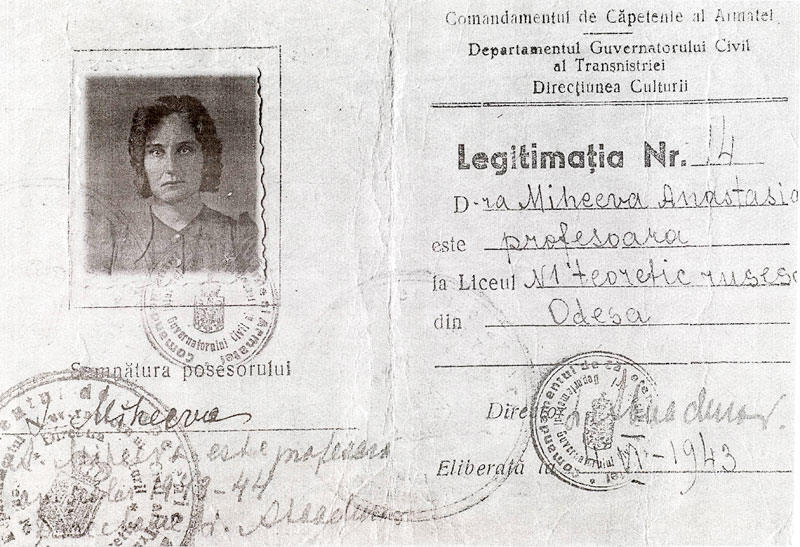 But what, after all, she was accused of, that Anastasia Mikheyeva, a teacher of chemistry at the Odessa Railroad school No. 1? “Extolling discipline at the Romanian educational institutions”: Anastasia Mikheyeva had ascertained the fact of greater attention given to foreign languages at school during the Romanian occupation compared to that during Soviet ruling. Moreover, a special educative hour was introduced unheard of in Soviet schools. “The pupils in Romanian schools step aside to let the teachers pass, and at our schools they can literally knock one down”.
But what, after all, she was accused of, that Anastasia Mikheyeva, a teacher of chemistry at the Odessa Railroad school No. 1? “Extolling discipline at the Romanian educational institutions”: Anastasia Mikheyeva had ascertained the fact of greater attention given to foreign languages at school during the Romanian occupation compared to that during Soviet ruling. Moreover, a special educative hour was introduced unheard of in Soviet schools. “The pupils in Romanian schools step aside to let the teachers pass, and at our schools they can literally knock one down”.
Mikheyeva was also accused of a willful intention to be not evacuated aiming to collaborate with the occupants. But she did intended to be evacuated, and she even had a marine transport ticket but she could not get aboard because of the abundant families with children and children by themselves.
“Disintegrating discipline at school” – well, yes, she let the children skip lessons but only on very cold winter days.
“Defamating Russian doctors” – well, yes, after the Russian hospital stay at school clutter and chaos was left behind, “it wasn’t a calumny”.
“Extolling life under occupation” – the occupation period salary received by Mikheyeva at school was sufficient for the properly organized everyday life; and after Odessa was liberated from the Romanian occupants Anastasia, having three jobs often was undernourished because the salaries were not paid in time.
Some witnesses in attendance, a few as they were, found courage to testify to Mikheyeva’s innocence.
There were also others who backed up the charge. And once more we are at a loss without understanding in which way those so-called “anti-Soviet sentiment” testimonies had been got.
November 28, 1960 while residing in Kirovograd, Mikheyeva has submitted an application for rehabilitation. November 9, 1961 the 1945 sentence was recalled, and she was rehabilitated. The rehabilitation documents clearly show the way political situation in the country has changed. The same persons who, as witnesses in 1945 trial testified to Mikheyeva’s guilt, under some pretext or other withdrew their guilty pleas when the case was under revision, saying in particular that they were misunderstood by the investigation officer and their testimonies were put down incorrectly. It should be borne in mind, however, that evacuated during the war people were prejudiced against those who found themselves under occupation. They must not have realized that it was the State which threw the millions of children, women, and elders into the hands of invaders.
Rehabilitation record of proceedings shows that Mikheyeva, according to witnesses, has saved several Jewish children from perishing (the fact, by the way, already known at the time of 1945 trial), and one of them, Marusya girl, is just that very Maya Rakitova who has turned for help to the World-Wide Club of Odessites.
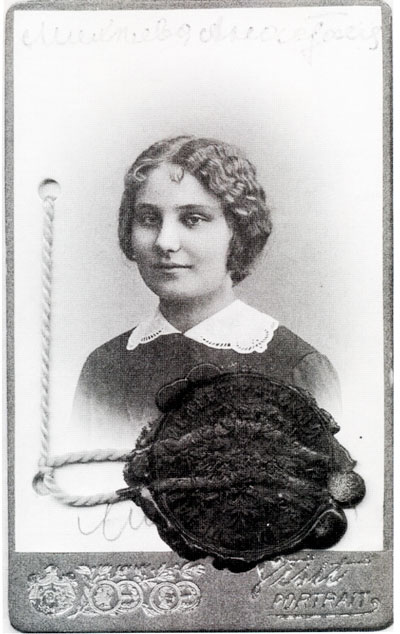 Anastasia Mikheyeva the student
Anastasia Mikheyeva the student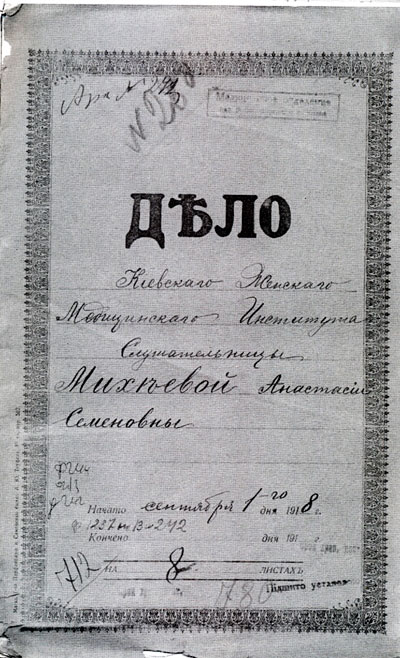 Personal file of A. Mikheeva
Personal file of A. Mikheeva
Being advised that Mikheyeva was a one-time student of the Institute of People’s Education in Odessa I engaged myself in searching her documents of that period. I was lucky to find the personal record of Mikheyeva the student.
It contained indication that before entering the Institute of People’s Education Anastasia had been a student of the Higher Medical Courses for Women in Kiev. I managed to get a copy of the girl student Mikheyeva Anastasia personal record.
In order to learn about Anastasia Mikheyeva as much as possible I have visited both the archives of the Odessa Railroad (because before the WWII and after 1944 liberation of Odessa she used to teach chemistry at the Railroad school No. 1, to-day school No. 16) and the people’s education department archives of the Primorsky district of Odessa where the school was situated. Surely I have visited the school itself. A curious coincidence: at the time Mikheyeva was teaching at that school my mother was a schoolgirl there.
I succeeded in finding two other jobs of Mikheyeva in Odessa: she taught chemistry both at a dental school and technological college of food industry.
To finish the picture I turned to the archives of Ministry of Internal Affairs of Russian Federation, it being the place where the papers on all convicts are stored.
Besides, I felt an urge to address the State Archives of Estonia (because the colony where Mikheyeva had been serving her sentence was in Narva, Estonia). A copy of her personal prisoner card was received.
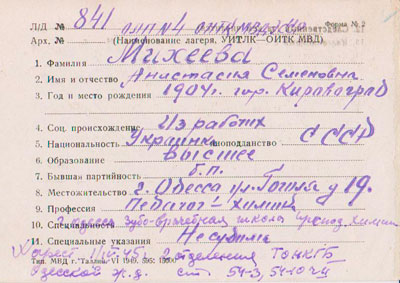 Prisoner’s card of
Prisoner’s card of
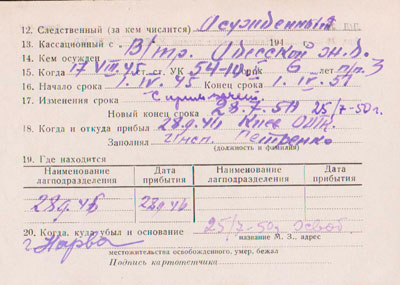 Anastasia Mikheyeva
Anastasia Mikheyeva
And the National Library of Estonia also has provided essential information on the colony wherein Mikheyeva was imprisoned: “From the second half of WWII in Narva and its suburbs a colony was functioning – with changing both contingents and commanders – at first these were Soviet POW, succeeded by German ones, after that the colony was occupied by political prisoners. By June 1946 the colony comprised 3000 convicts. The first party numbering 2000 came from Ukraine after the end of WWII. The colony consisted of three camps, including one in Narva suburbs. In 1946 the camp was subjected to the uranium mining complex construction office”. The State Archives of Estonia informed that the colony existed until 1955.
Since Mikheyeva was rehabilitated by the Odessa Regional Court ruling of 1961 I approached also the archives of Odessa Appelate Court as a legal successor to the above in order to receive the copy of its decision.
And now it is high time to summarize.
A person who risked her life to rescue Jewish children – and such a bleak fate… But all the same – justice triumphs, sooner or later.
Facts from Maya Rakitova’s letter were validated. It could not rest unacknowledged by Yad-Vashem, the Holocaust Victims and Heroes Memorial Museum in Jerusalem where the Righteous of the World title is awarded.
 The title is awarded to those who came to the rescue of Jews in the occupied zones during the WWII. Their names are carved into a stone stele at the Righteous of the World Alley in Yad-Vashem Museum. The medal itself is awarded whether to the Righteous of the World personally or, posthumously, to his/her relatives.
The title is awarded to those who came to the rescue of Jews in the occupied zones during the WWII. Their names are carved into a stone stele at the Righteous of the World Alley in Yad-Vashem Museum. The medal itself is awarded whether to the Righteous of the World personally or, posthumously, to his/her relatives.
In pursuit of Anastasia Mikheyeva’s relatives I addressed the Mayor of Kirovograd, a town whereto a rehabilitation verdict was directed in 1961 because Mikheyeva resided there.
According to information received, 09.06.1954 through 21.02.1978 Anastasia Mikheyeva has been working as a laboratory doctor-assistant at the “Krasnaya Zvezda” (“Red Star”) works hospital (4th municipal hospital later on). Anastasia Mikheyeva has passed away October 11, 1978.
She appeared to have no relatives left in Kirovograd. This being the case, a provision is made that it is the rescued person personally who decides where the award is to be preserved.
Anastasia Mikheyeva’s name will be carved both into the stone stele at the Righteous of the World Alley in Yad-Vashem Museum in Jerusalem and the stele in the memorial Prokhorovsky Square in Odessa (Ukraine) added to other Righteous of the World names.
When the article was ready we sent it to Canada, to Maya Rakitova, and very soon she answered:
I have read the material very attentively.
I was relieved at once realizing that owing to your efforts the memory of Anastasia Mikheyeva will live forever.
Respectfully,
Maya Rakitova
*SBU (Security Service of Ukraine) – the successor to former KGB (Committee of State Security in the former Soviet Union)
*Transnistria – a part of the Ukrainian territory between the rivers Yuzhniy Boog and Dniester
Internet-dossier:
Maya Rakitova reminiscences “Two Victories of My Mother” were published in “Holocaust and Modernity” magazine edited by Holocaust Studies Center, Kiev, 2009, No. 1(5).
